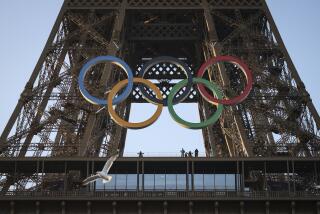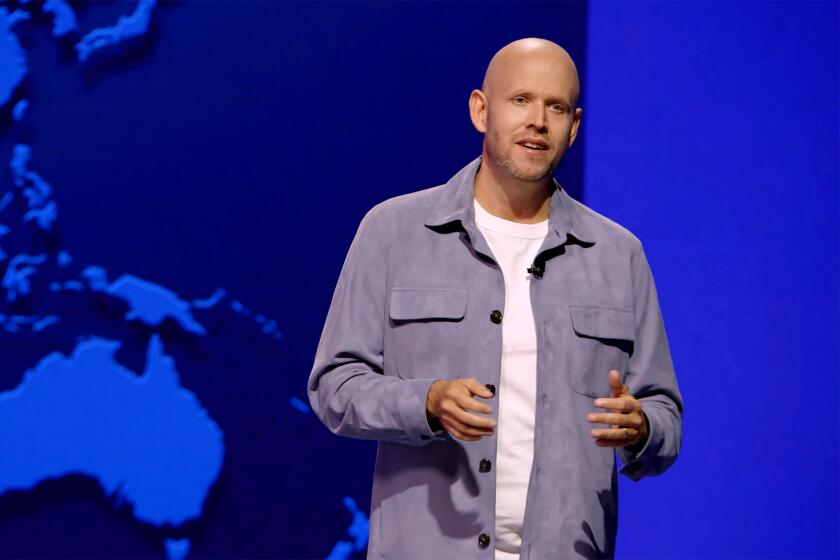Critic’s Notebook: ‘Urbanized’ examines the growth of city life
Here’s a series of statistics that I continue to find staggering no matter how many times I come across them — or cite them myself. In 1900, according to the London School of Economics, 10% of the world’s population lived in cities. Five years ago the figure reached 50%. By 2050 it is likely to be 70%, or even 75.
That headlong rush into the world’s cities — and its implications for the environment, architecture and the way we live — is the subject of “Urbanized,” a sharp, good-looking documentary by Gary Hustwit that will have its first Los Angeles showings Sunday evening at the Independent theater downtown. The film, which premiered this month at the Toronto International Film Festival, features interviews with the architects Rem Koolhaas, Yung Ho Chang, Alejandro Aravena and Ricardo Scofidio along with mayors, activists and planners. It is both a love letter to urban life and a cautionary tale about what happens when more newcomers crowd into a city, or the slums on its outskirts, than the place can begin to comfortably absorb.
All in all — despite a pretty obvious blind spot in Hustwit’s thinking about cities like Los Angeles — “Urbanized” ranks among the smartest recent analyses of mass global urbanization and its discontents. Think of it as a cinematic version of “The Endless City,” the book that Ricky Burdett (who plays a significant role in “Urbanized”) and Deyan Sudjic put out three years ago. Even as it races around the globe and through centuries of urban history, “Urbanized” manages to keep from feeling overcrowded with ideas or talking heads. It is intelligently edited to keep its own density, in other words, in check.
Now, about that blind spot. The movie leaves out Los Angeles altogether. But it’s not the omission itself that’s worth pointing out; it’s that Hustwit seems not to have made even theoretical room in his otherwise wide-ranging approach to cities and architectural history for megalopolis like ours, with its decentralized, medium-density and freeway-linked character.
This becomes clear just a few seconds into the movie, when the architect Norman Foster, speaking in an all-knowing introductory voice-over, argues that “the thing that attracts us to the city is the chance encounter, the knowledge that you’ll be able to start here, end up here and go back there, but that something unexpected will happen along the way, that you’ll make a discovery.”
As anybody who has spent much time here knows, a key element of the civic personality of Los Angeles — and many places like it — is that it manages to be an inventive and globally important city without giving its residents the chance to discover much of anything “along the way.” The city’s emergence in the 20th century suggested that metropolitan regions, for better and worse, could grow huge while seeming to rule out the sort of serendipity that Foster holds up as an urban ideal.
Hustwit’s decision to steer clear of Los Angeles — made up for to a degree when the film spends a few desultory minutes examining suburbs outside Phoenix — seems all the more noticeable because so many of the themes the documentary grapples with find their clearest distillation here, in increasingly heated debates about how to retrofit L.A. for a post-suburban future.
One of those themes is parking. Enrique Peñalosa, the charismatic former mayor of Bogota, Colombia, is given a substantial amount of screen time for a winning analysis of the relationship between cars and urban form, which he introduces by noting that “many things about cities are very counterintuitive.”
For example, he says, “it seems to us that making bigger roads, or flyovers, or elevated highways, will solve traffic jams.… But the more road infrastructure you do, the traffic will become even worse.”
Are you thinking — Carmageddon — what I’m thinking?
“The only way to solve traffic jams,” Penalosa goes on, “is to restrict car use. And the most obvious way of restricting car use is restricting parking.” The problem with that strategy, as he points out, is that “people seem to imagine that parking is a right, almost a fundamental right, to be included in the United Nations charter. In our constitution there are many rights: the right to housing, the right to education, the right to health. But I don’t find the right to park.”
“Urbanized” — the third in a trilogy of documentaries by Hustwit, following films on graphic design (the Helvetica typeface, to be exact) and industrial design — will leave Angelenos feeling left out in yet another way. As it catalogues the most remarkable civic projects to be completed in recent years it seems to travel everywhere but California. Here’s the High Line in New York. Millennium Park in Chicago. New bike lanes in Copenhagen. Imaginative public housing in Santiago. And in this regard I can’t fault the movie: Los Angeles has plainly fallen behind other cities when it comes to innovative thinking about urban design.
The film, to its credit, offers more than a laundry list of impressive buildings and plans. It explores the political and architectural challenges posed by favelas and other informal settlements. It ends with a sustained look at controversial plans to build a new train station and mixed-use development in the German city of Stuttgart.
And it includes the most memorable critique I’ve yet heard of Brad Pitt’s Make It Right Foundation, a nonprofit group that hired several talented architects, including Thom Mayne, Shigeru Ban and David Adjaye, to build sustainable prototypes for new housing after Hurricane Katrina flooded New Orleans. The analysis comes — in martini-dry form — from Grover Mouton, director of the Regional Urban Design Center at Tulane.
He refers to Pitt with what is either genuine or tongue-in-cheek naivete — I suspect the latter — as “the movie star,” professing to have forgotten his name. And he zeros in on the limitations of projects like Make It Right, which wound up producing a series of architectural one-offs rather than a blueprint for sustainable development in New Orleans at the level of the block or neighborhood.
“The problem with the Lower Ninth Ward is that there is no urban-design recovery plan,” Mouton says. “It’s a bunch of architects from the West Coast coming in doing all these buildings. To do something like that without a plan — and without a landscape plan, or a landscape architect — goes against every simple little rule” of urban planning and civic design.
Mouton concludes with a line that might as well serve as the mission statement for “Urbanized,” given the movie’s interest in looking beyond the flash created by high-profile architectural icons to understand the role of comprehensive, forward-looking planning in improving city life.
“Just because the architects are so divinely wonderful,” Mouton says, “isn’t going to make the place wonderful.”
More to Read
The biggest entertainment stories
Get our big stories about Hollywood, film, television, music, arts, culture and more right in your inbox as soon as they publish.
You may occasionally receive promotional content from the Los Angeles Times.











